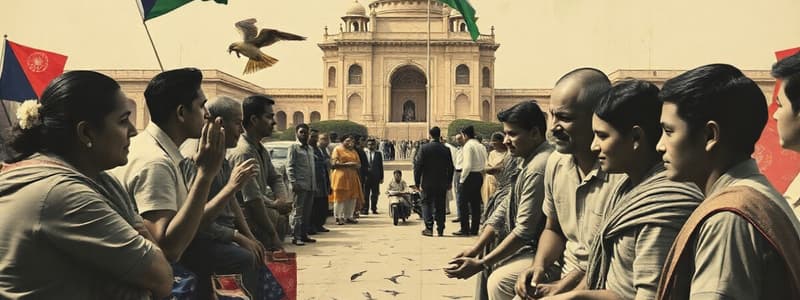Podcast
Questions and Answers
Which of the following best describes the term 'marginalization'?
Which of the following best describes the term 'marginalization'?
- The social process by which certain groups are pushed to the edges of society, limiting their access to resources and opportunities. (correct)
- The act of celebrating the cultural uniqueness of various communities within a society.
- The process of providing additional resources to minority groups to uplift them.
- A government initiative to redistribute wealth equally among all citizens.
How does the Indian Constitution address the issue of marginalization?
How does the Indian Constitution address the issue of marginalization?
- By granting special privileges to the majority community to maintain social order.
- By establishing a separate legal system for marginalized groups.
- By providing Fundamental Rights to all citizens, including the right to equality and the prohibition of discrimination. (correct)
- Through directive principles that encourage social harmony.
What is the primary purpose of the reservation policy in India?
What is the primary purpose of the reservation policy in India?
- To ensure proportionate representation of all castes in government jobs regardless of historical inequalities.
- To maintain the dominance of certain privileged groups in educational institutions.
- To promote economic development by prioritizing candidates from wealthier backgrounds.
- To allocate seats in educational institutions and government jobs specifically for Dalits and Adivasis, addressing historical inequalities. (correct)
Which of the following is the main function of the Scheduled Castes and Tribes (Prevention of Atrocities) Act of 1989?
Which of the following is the main function of the Scheduled Castes and Tribes (Prevention of Atrocities) Act of 1989?
In what ways do marginalized groups challenge their societal positioning, as mentioned in the text?
In what ways do marginalized groups challenge their societal positioning, as mentioned in the text?
Which article of the Indian Constitution abolishes untouchability?
Which article of the Indian Constitution abolishes untouchability?
If a new policy is introduced which unintentionally disadvantages a particular marginalized group, what recourse do these groups have based on the information provided?
If a new policy is introduced which unintentionally disadvantages a particular marginalized group, what recourse do these groups have based on the information provided?
A school denies admission to a student based on their caste, despite them meeting all academic requirements. Which constitutional provision is being violated?
A school denies admission to a student based on their caste, despite them meeting all academic requirements. Which constitutional provision is being violated?
Flashcards
Marginalization
Marginalization
The process where groups are pushed to the edges of society, limiting their access to resources & opportunities.
Fundamental Rights
Fundamental Rights
Rights guaranteed to all citizens, protecting them from discrimination and ensuring equality.
Indian Constitution's role
Indian Constitution's role
A framework to combat marginalization through rights like equality & prohibition of discrimination based on caste, religion, or gender.
Article 17
Article 17
Signup and view all the flashcards
Reservation Policy
Reservation Policy
Signup and view all the flashcards
Purpose of Reservation Policy
Purpose of Reservation Policy
Signup and view all the flashcards
Prevention of Atrocities Act (1989)
Prevention of Atrocities Act (1989)
Signup and view all the flashcards
Response of Marginalized Groups
Response of Marginalized Groups
Signup and view all the flashcards
Study Notes
- Marginalization pushes certain groups to the edges of society, limiting their access to resources and opportunities.
- Marginalized groups often include Dalits, Adivasis, women, and other minorities.
- Confronting marginalization involves challenging inequalities and seeking justice and equality.
Legal Framework and Fundamental Rights
- The Indian Constitution combats marginalization using Fundamental Rights available to all citizens.
- This includes the right to equality and the prohibition of discrimination based on caste, religion, or gender.
- Article 17 abolishes untouchability, ensuring Dalits can access education and public facilities without discrimination.
Government Policies and Schemes
- The government implements policies promoting social justice for marginalized groups.
- Reservation policies allocate seats in educational institutions and government jobs for Dalits and Adivasis.
- This addresses historical inequalities and provides equal opportunities.
The Scheduled Castes and Tribes (Prevention of Atrocities) Act
- Enacted in 1989, this act legally protects Dalits and Adivasis against discrimination and violence.
- It addresses various forms of atrocity against these communities.
- The Act ensures offenders face stringent punishment, protecting the rights of these groups.
Role and Response of Marginalized Groups
- Marginalized groups challenge their societal positioning by invoking their rights under the Constitution.
- They engage in protests and movements to demand equal treatment.
- They also influence the formulation of laws that protect their rights.
- The abolition of untouchability and the recognition of land rights for Adivasis illustrates their struggle to reclaim dignity and access to resources.
Conclusion
- Confronting marginalization requires awareness and advocacy to achieve social equality.
- Understanding the legal framework, government policies, and the participation of marginalized communities is crucial in fostering an inclusive society.
Studying That Suits You
Use AI to generate personalized quizzes and flashcards to suit your learning preferences.
Description
Marginalization pushes groups to the edge of society, limiting access to resources. The Indian Constitution combats marginalization using Fundamental Rights for all citizens, including the right to equality and prohibition of discrimination. Government policies promote social justice through reservation policies.




